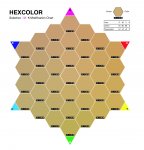Alith7
Well-known member
Here is a scan of another, 50-odd years old Ink Quiz, much like Gordos'.
In this quiz 3 inks were printed on 9 different paper stocks, die-cut in successively larger triangular holes, stacked and stapled together to form a small booklet.
Many times this helped me illustrate with minimal verbal explanations...
That is a beautiful thing!! I'm kind of jealous!
arossetti~
That is exactly what i'm saying. in regards to what started the discussion, he was asking how he can best designate a color to be stable across all platforms, print methods and paper types. and while yes, specifying a LaB value will give you a measurement target that will do just that, it may also put you in a spot where you are telling your customer to "Do this and everything will be ok" when in reality, it could cause more headaches than it solves. There's also the added complication on the printer's end where they now have to figure out what curves, adjustments and shifts are needed to achieve that LaB value for each project. Which while in theory should be all in the profiling, I know from experience that once in practice, it doesn't matter what curve you throw at it, you will need to alter the CMYK breakdown of an orange differently than a purple when switching stock types.
my example: I have a customer that wanted their brand colors to match across the board, after a few different swatch tests mixed in with different runs, we settled on the following different breakdowns, and you could put the coated/uncoated, CMYK/PMS, digital all side by side and get a match. We specifically helped them to pick a PMS shade of orange and purple that had the least amount of color shift from coated to uncoated printing.
This is what we used:
PMS 159 / Coated/Digital CMYK: C-0, M-60, Y-80, K-10 / Uncoated CMYK: C-0, M-50, Y-70, K-8
PMS 273 / Coated/Difital CMYK: C-100, M-96, Y-0, K-8 / Uncoated CMYK: C-85, M-85, Y-0, K-0
If you tried to apply the same adjustment curve to both colors (assuming only using the Coated CMYK seps) to achieve the match on uncoated, you would be able to match one of the colors, but not the other. Just for reference this is in the US, so printing to GracoL profiles, and calibrated and maintained G7 standards on all equipment and presses.
The bottom line comes down to this, if you are dealing with a customer that can't grasp or accept the idea of WHY you need different CMYK breakdowns for different methods and materials, they are more than likely not going to be able to understand why that LaB value isn't going to make it "look like it does on their screen".












